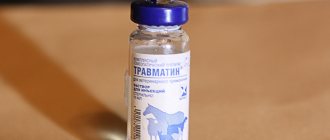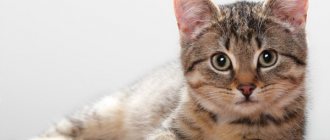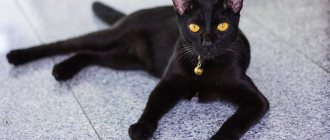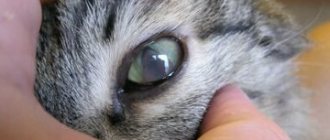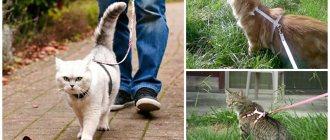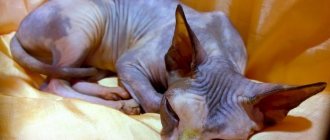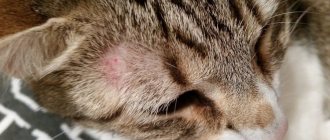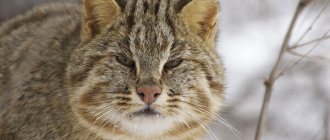10218Administration
2
All British cats purchased from a cattery have an individual pregnancy, the longest being 10 weeks (70 days). Often a British cat will give birth at 8-9 weeks. The beautiful short-haired creatures, anticipating an imminent event, are very worried and look for a suitable place in advance. And some realize what is happening already during contractions. This article describes in detail how to act correctly.
Before the onset of labor, literally a few days before, active movement begins in the tummy, even during the rest period.
How can you know for sure that a British mother is about to give birth? You must not miss the moment when the birth plug comes off . This is quite difficult, because she can lick it or bury it in the filler sand. But if, when cleaning the tray, you find a small white-pink clot, then it’s time to get ready. It is highly advisable to take a few days off from work, because she will need help.
© shutterstock
You also need to carefully monitor when her water breaks - this is the beginning of labor. By this time, a place for childbirth and further accommodation should be ready, as well as special food after childbirth.
If it has already happened, then you should expect the first contractions.
Term
The British Shorthair is considered mature when it is 8-9 months or older. The first heat occurs much earlier, but it is better to wait until mating until 1 year. Then the pet’s body will be completely ready for gestation and childbirth.
After mating, pregnancy will not yet be visible. First of all, the estrus will pass, and only then, after a few days, the first signs of fertilization will appear. The gestation period does not exceed 9 weeks .
The first fact that indicates that a British Shorthair is pregnant is swollen nipples that have turned pink. They are visible within 3 weeks (20-22 days) after fertilization. Meanwhile, the appetite noticeably increases, the animal becomes calm, rests and sleeps more.
Symptoms and signs
The pregnancy of a British cat is divided by weeks into three periods, in each of which certain symptoms are observed.
Your pet becomes less active
From 1 to 3 weeks of pregnancy:
- The cat's activity decreases and she begins to sleep more.
- The pet becomes more affectionate and strives to spend more time with its owner. Sometimes a cat's character can change, on the contrary, towards aggression.
- Toxicosis may occur: vomiting is observed, as a rule, in the first half of the day, and can be repeated several times a day. As a result, your cat's appetite may decrease. It should be noted that toxicosis does not always occur.
- Around the end of the third week, a sign such as a change in the color of the nipples appears: they become more pink, may increase in size and peel off.
Attention! The most reliable method for determining the onset of pregnancy is an ultrasound examination. Using an ultrasound, you can confirm pregnancy as early as 2-3 weeks.
From 4 to 6 weeks:
- The cat is gaining weight, the belly is noticeably enlarged.
- Appetite improves.
- The animal avoids jumping from heights and fast running.
The animal is gaining strength.
In the last 2-3 weeks, the cat has been resting a lot, gaining strength. She is also looking for a secluded place in which the birth will take place.
Pregnancy time
During pregnancy, cats of the British breed will have to abstain from fish and seafood, as they can destroy the B vitamins that she and future offspring need. An excellent replacement would be yogurt mixtures, curd mass, and kefir. They contain a lot of calcium, which contributes to the proper formation of the cat's skeleton.
© shutterstock
On the 35th day, a rounded belly is already clearly visible, weight increases, as a result of which the gait and lifestyle in general changes (he stops running, playing, and is more capricious). When you touch it with your palm, you can feel the kittens moving.
On day 49 it is already possible to determine the number of babies. The expectant mother will become more thoughtful and slowly begin to look for a comfortable place.
By week 7, everything should be fully prepared for the upcoming event. After all, a couple of weeks and the British cat will become a mother after giving birth.
Gestation of kittens, like the natural process of childbirth, occurs differently in British cats, but there are still common signs, such as:
- active movement of babies, British cat sleeps for a long time;
- removal of the birth plug;
- breaking of water (100% sign of the onset of labor).
How to tell if a cat is pregnant
Pregnancy tests have not been invented for animals like they are for humans. However, certain signs can help an attentive owner:
- The first thing that comes to mind for many owners is weighing. There is logic in this, but it is worth noting that the straight-eared British pet will not gain much weight. Consequently, such a diagnostic method is inaccurate, so there is no point in weighing it many times.
- But changes in the abdominal area are a more accurate sign. The nipples begin to turn pink, become larger, and the belly increases. Such precursors of pregnancy may begin to appear around the 35th day. But you should also keep in mind that nipples sometimes become a little larger simply on estrus days.
- Another harbinger of pregnancy is vomiting. It is especially typical in the first half of the day. As a rule, the British straight-eared pet is at this time in the 3rd or 4th week of pregnancy. Reasons: stretching of the uterus, hormonal changes. Refusal to eat and depression are a common accompanying factor in this condition. It can be repeated many times over several days.
- Palpation is an effective method, but only permissible when carried out by a specialist. Careless palpation can damage pregnancy and cause miscarriage. In addition, there is a high probability of confusing the kittens with something.
Prenatal period
First, you should think about the place where the expectant mother and her newborn babies will live. Most often, pregnant women look for it on their own; absolutely any corner in the apartment/house becomes it. But it is much better if the owners arrange it well in advance: prepare a box, soft fabrics, and possibly a cardboard lid.
There is one condition: the bulk box that will be used as a cat house must have a removable lid. It will give the owners the opportunity to observe the process, even if the pregnant woman wants to give birth alone. From time to time you will need to lift the lid to make sure everything is going correctly. Make a passage in the box itself so that the pet can exit without obstacles.
© shutterstock
Cover the bottom of the constructed cat house with a warm soft cloth and cover the top with a disposable diaper.
True, it is still unknown whether the British cat will like the good conditions for childbirth chosen by the owner and the place; perhaps she will find another, more suitable for herself and her children.
Mating of British cats
When it became clear how long British cats walk, it is necessary to find out what signs to determine that you need to look for a cat for breeding: a British cat begins to meow loudly and roll on the floor, she experiences sudden mood swings and changes in her gait.
Mating a British cat with a British cat is considered the most important stage for the birth of healthy offspring. It has many nuances and features.
If a British cat begins to walk for the first time, this is not an indicator that she can begin to be mated with cats. To understand that a British cat has gone on a spree for the first time, the owner needs to understand the signs of estrus. This is a change in the pet’s mood, habits, daily routine and diet.
There are two rules that will help maintain the health of a British cat and get healthy offspring:
- It is forbidden to breed during the first heat. This can greatly harm your pet's health.
- Do not delay with tying. Otherwise, you may encounter problems of a sexual nature - a violation of the frequency and duration of estrus, the development of polycystic disease, and distortion of life cycles.
Taking these conditions into account, the moment is calculated when you can breed a British cat. You should also take into account the fact how many days she walks.
There are a number of rules that you need to remember before introducing your pet to a cat.
You cannot suppress estrus with medications. Before adopting pets, you need to make sure they are vaccinated against infectious diseases. These include vaccines against rabies, rhinotracheitis, panleukopenia, and calcevirus infection (the last two are included in a complex injection).
Two weeks before mating, the pet needs to be dewormed (to drive away worms).
By following these rules, you can protect animals from many problems.
In addition to the rules that exist for females, owners of British cats also need to create certain conditions and requirements that will keep their pets healthy.
- First of all, British cat owners need to help their pets when difficulties arise and control the process.
- If this is the first mating of a Briton, it is necessary to carry it out with an already mated pet. Otherwise, both animals may suffer psychological trauma.
- The owner of a Briton must bring a cat with its claws trimmed for mating.
These conditions must be met in order to get healthy offspring and not injure the partner.
Complications
If a British breed cat is about to give birth for the first time, you should prepare for possible complications. Therefore, you need to prepare everything in advance. So, for childbirth you will need:
- phone number of the veterinarian, because something could go wrong;
- sterile disposable gloves;
- scissors treated with alcohol;
- Vaseline oil;
- small oilcloth (several pieces, because it will need to be changed during the process if it gets dirty);
- antiseptic (alcohol);
- cotton pads;
- nylon thread;
- syringes 2 and 5 ml;
- calcium gluconate injection.
In addition to all this, you need to know how to prepare a cat for childbirth.
When does puberty begin in British cats?
Before you think about breeding and mating, you need to know at what age British kittens begin to walk and when their puberty begins. Puberty can begin from 4 to 12 months. On average, this period ranges from 7 to 9 months of age. Puberty of British cats depends on the following factors:
- Breeds. British breeds mature later than oriental breeds (Siamese, Thai).
- Skeletal structures. Thin-boned pets mature earlier.
- Seasons. British kittens that reach six months of age in the summer will begin maturation earlier than their “winter” counterparts.
- Care. With proper maintenance and nutrition, the pet will grow up and develop faster. It is important that his diet contains enough vitamins and minerals necessary for active development.
- Genetics. Hereditary diseases or mutations greatly affect the development of the animal.
- Society. When maturing together with other British cats and female cats, the process of puberty lasts faster than when a kitten forms alone.
It is easy to determine that a British cat has reached reproductive age and is ready for pregnancy and childbirth. She's about to go into her first heat.
When breeding British cats, it is necessary to take into account not only the time of estrus, but also its frequency. In this way, you can accurately plan the mating date and look for a worthy candidate for breeding offspring.
READ How to properly treat diarrhea in a cat after giving birth
It is important to distinguish between when a British cat that has not yet been mated and one that has been mated is in heat. A British female may come into heat once every 2-3 months. Because of this, owners who do not intend to engage in breeding try to sterilize the cat at an early age.
Estrus in a female that has already been bred may occur once every 3 months. With constant pregnancy after estrus, the period of its appearance can last up to six months.
Based on the information received, you can determine how often your pets go for walks and when is the best time to breed them. It is also important to know how long the estrus lasts in British breed cats. This is an individual process, but its average duration is 5–6 days.
Symptoms of beginning labor. How to use
If you do not take into account individual periods of gestation, from the moment of conception the British mother is calmer, sleeps longer and eats very well.
Precursors of childbirth in the British breed can come as a complete surprise to the owners. But on the day of giving birth, her behavior changes dramatically. The pet of the British breed is overcome by severe anxiety, she runs around the living space like crazy or follows on the heels of her family. Also, her desire to eat suddenly decreases.
24-30 hours before the upcoming birth, the British cat begins to wander, making rather loud, incomprehensible sounds. This is a signal about the beginning of the first contractions. They can last about 12-14 hours, and are accompanied by heavy discharge.
In theory, the duration of labor for a British cat is about a day from the moment of the first contractions. But perhaps less (7-8 hours). The time depends on the number of kittens.
During a difficult period, it is advisable to be nearby, massage the abdomen, stroke, and soothe.
Interesting information
Young representatives of the British breed reach the required age for mating only at 6-7 months. Then fertilization is already possible, but in most cases the first pregnancy occurs only after 1 year of life. The reason for this is the inability of a 7-month-old cat to fully bear a fetus. This applies equally to representatives of both sexes, since in British cats early matings can lead to a shortening of the fertile period.
In each pet, the average number of heats is reduced to two per year. But if your British pet lives only in the house, then this may happen much more often. Approximately every 15-25 days, and their duration is 6-8 days.
But it is important to remember that the process of mating representatives of the British breed does not always end in pregnancy. Therefore, it is necessary to take this significant nuance into account.
Second phase
The second stage is the natural birth of British babies. They should come out head first (it rarely happens the other way around), in the amniotic sac, which the new mother bites through and at the same time gnaws through the umbilical cord.
If there are more than 3-4 kittens, it is quite possible that she will not be able to take all the necessary steps on time. This is where a person will have to take responsibility.
How to give birth to a British cat? It is necessary to carefully release the kitten from the amniotic sac, wipe it, cut the umbilical cord, leaving up to 2 cm from the abdomen. Carefully treat the edge of the umbilical cord with an antiseptic. You need to carefully examine the newborn, make sure that breathing is uniform , if not, then you need to lower him head down and hold him in this position until he squeaks. The tongue should be pink.
© shutterstock
Place all the kittens in one place. As soon as the stages of labor for the British cat are over, bring a spacious box of kittens to the British cat so that she lies down next to them and feeds them.
Diet of a nursing cat
Immediately after the last kitten is expelled, the cat's uterus begins to rapidly contract. The birth is considered complete if the cat does not experience contractions within 1.5–2 hours, all kittens and placenta are expelled, and the peritoneum is soft on palpation. If the placenta has been eaten, the nursing cat does not eat after giving birth and does not leave the nest for 4–6 hours. However, offer your cat water or warm milk.
The diet of a nursing cat after giving birth for 10–12 days should consist only of easily digestible, nutritious and natural foods - milk and fermented milk products, vegetables, cereals. If your pet literally suffers without animal proteins, then you can add some boiled dietary meat to the menu. It is advisable to exclude dry food - it contains a lot of salt and little water, and is not the best product for abundant milk production. Allergy sufferers, British cats and other artificial breeds are an exception; a sudden change in diet is contraindicated for them.
From day 14, “usual” foods are gradually introduced into the diet, including boiled meat and fish. If there were no complications during the postpartum period, by day 14 the cat will have fully recovered, but the kittens will also grow significantly. The pet’s body needs a large amount of products containing calcium and magnesium, otherwise the mother’s bones, teeth and joints will suffer from a deficiency.
As prescribed by a veterinarian, food supplements with a high calcium content are prescribed for lop-eared offspring. Particular control is given to the correct formation of joints. Cute curled ears, unfortunately, are a mutation that will not occur when there is enough calcium in the body.
Milk and low-fat cream should be present in the cat's diet during the entire period of feeding the kittens and for 20–30 days after weaning the cubs.
There are no strict recommendations on how to properly feed a cat after giving birth, but it is important to follow several rules:
- Feed your animal only fresh food.
- Make sure that drinking water is always freely available.
- Split portions - feed more often, but little by little.
- Monitor your pet's weight; obesity is not beneficial.
- Follow the diet strictly if prescribed by your doctor.
- Protect your pet from hunting, a collar with a bell will help.
- Buy food in advance; a nursing cat should not go hungry.
The cat had an important event - the birth of kittens. Tiny lumps need adequate nutrition, which depends on the diet of the furry mother herself.
A caring owner immediately has questions: “How to feed a nursing cat and how to properly care for her and her babies?” This period is very important in the life of a cat and its offspring. By experiencing the joy of the birth of babies with her, the owner helps ease the hardships of motherhood.
Immediately after birth
She may not immediately develop a maternal instinct. It happens that she doesn’t even want to approach her children. There is nothing terrible here, she just needs to get used to the new status, and the owner/mistress will help with this. All you have to do is put the babies' heads to her nipples yourself.
Not all at once, but one at a time, so it will be easier for her to get used to it, she will feel the familiar smell and after a short period of time she will recognize them as her own. The main thing is that the kittens start eating, then everything will definitely be fine.
You should definitely praise the domestic four-legged short-haired beauty, stroke it, and be nearby when she feeds the kittens for the first time.
At first you will have to bring food to the built house, since at first it will lie next to the kids for days on end. And after such stress, you definitely need rest and recuperation.
It is important to know
After the birth of each baby, the birth of the placenta continues, which some eat. Here you need to be very careful, not to miss the moment, in order to protect yourself from possible infections and postpartum complications.
It happens that a British new mother's labor is interrupted. That is, the first few babies are born first, and after that the maternity process is interrupted for a whole day.
Then they resume and the rest of the babies are born.
There are times when giving birth to a British cat at home requires contacting an experienced veterinarian, for example:
- bleeding;
- pelvic fracture;
- severe obesity;
- newborn stuck in the birth canal.
Mechanical blockage - the fetus is too large or is in the wrong position. Here, stimulant drugs are strictly prohibited, as they can lead to rupture of internal organs.
© shutterstock
Giving birth to a cat at home
You are calm. You are simply an example of balance. You are a clear example of confidence in a favorable outcome of childbirth!!! She (the cat) is afraid, she is worried, she hopes for you. You have no right to disappoint her expectations!!!
And therefore - you know there are three periods of childbirth:
in the first period, the cervix dilates and the birth canal opens; in the second , kittens are born; in the third , the afterbirth comes out (is born).
The cat's uterus is bicornuate. The horns, at the point of their connection, pass into the uterine canal, which passes through the cervix into the vagina, and it, through the vestibule of the vagina, into the vulva - this is the birth canal. The fetuses, protected by the amniotic membrane and fixed to the wall of the uterus by the placenta, are located in the horns of the uterus.
The beginning of labor in a cat. Signs of the onset of labor in a cat
The first stage of labor can last from 12 to 24 hours. In the initial stage it may not be noticeable. It all starts with chaotic, voluntary contractions of the uterus (pushing), breathing quickens, the cat purrs to the beat. These contractions, in the form of peristaltic waves from the top of the uterine horn to its body, are at first rare and weak, the pain is of an unclear nature.
A few hours before contractions, the vagina swells slightly, and a thick sticky discharge appears from it, transparent, yellowish or bloody in color. The animal, at this time, is restless, licks the vulva (loop), strains, as if during defecation, meows pitifully, and rake up the bedding. The uterine horns contract alternately, pushing the fetuses into the uterus.
As the labor process progresses, contractions become more frequent, their duration increases, and the pain intensifies. When the uterus contracts (contractions), the fetus is pushed towards the cervix and it dilates. At the same time, the abdominal muscles contract and the fetus moves into the vagina. The cat at this time is completely at the mercy of childbirth. A first-time cat can be extremely frightened; she screams pitifully and seeks help from her owner. While watching her, constantly talk and pet her.
During contractions, intrauterine pressure increases and the vascular membrane (chorion) ruptures. The amnion (water membrane) and allantois (urinary membrane), filled with fluid, are embedded in the cervix, expanding its canal like a hydraulic wedge. From this moment, the cervix, uterus and vagina form one wide birth canal. During the formation of the birth canal, the presentation and position of the fetus is established for its exit from the uterine horn.
Gradually, pushing joins the contractions. They are caused reflexively, as a result of irritation of the nervous elements in the tissues of the cervix and pelvic walls by the presenting parts of the fetus. If you put your hand on the female's belly while pushing, you can feel it hardening. The pain continues to intensify, causing the cat to meow more and more pitifully and breathe frequently (like dogs in the heat). In between attempts she relaxes. Under the influence of contractions, supported by pushing, the fetus passes deeper and deeper through the birth canal.
Gradually moving forward, the kitten comes out into the pelvis, and then is forcefully pushed further towards the exit from the vagina, passing part of the way with a strong contraction.
The process of giving birth in a cat
From this moment the second stage of labor begins.
Usually on this section of the path the strength of the contractions is greatest. The water sac (amnion) surrounding the fetus appears between the labia of the vulva, ruptures, and a straw-colored fluid flows out. This is the release of amniotic fluid. Amniotic fluid lubricates the passage, facilitating the advancement of the fetus. Finally, part of the kitten (paw, head, tail) appears from the loop, appearing and then disappearing again.
As a rule, at this moment the cat relaxes and rests to gather strength before the birth. In classic cases, the cat makes two strong attempts at once and expels the kitten, connected by the umbilical cord to the placenta. The kitten is born with or without the membrane. About 70% of kittens are born in the "diver" position - with their forelimbs and nose first.
The cat independently treats the baby, gnawing the membranes (if any), intensively licking the kitten's face, clearing its nose, mouth and body, thereby stimulating the kitten's breathing and blood circulation, causes the first separation of feces, after which it gnaws the umbilical cord.
The kitten takes a sharp breath, its lungs expand, and it begins to breathe. Maternal instinct is a very important connection. The cat understands that this is her “baby” and she is obliged to take care of him. Sometimes, from the outside it seems that she does everything rudely, but in fact, she stimulates the cub’s breathing and blood circulation. For some time, after the birth of a kitten, the cat rests, then contractions and pushing resume, and the birth of the next kittens occurs.
Most cats kitten at intervals of 15 minutes to an hour. Two or three kittens can be born one after the other, but the next ones can be expected within another 3-4 hours, and sometimes longer. If a mother, while handling another kitten, forgets to remove the amniotic sac, you must do it for her very quickly, otherwise the kitten will suffocate.
The third stage of labor in a cat
The third stage of labor marks the separation of the placenta (baby place), which is born a few minutes after the birth of each kitten. The mother will try to eat some or all of the placentas. This is a purely instinctive reaction, which may have been preserved from those ancient times when the animal had to strengthen its strength and destroy all traces of childbirth in order to save its offspring. However, she may not do this.
Eating afterbirth leads to a laxative effect, that is, diarrhea. You can limit the amount of afterbirth you eat or let him eat them all. Cats chew the umbilical cord, grinding it (in this case, the blood vessels are twisted and overstretched and bleeding does not occur). If it is crossed too smoothly or too close to the navel, bleeding occurs. The umbilical cord should be compressed, tied with thread and cauterized with iodine or some other suitable antiseptic. It is important not to tighten the umbilical cord too much, so as not to provoke a hernia.
Once some or all of the kittens have been born, the cat lies on her side and pushes them towards her nipples. Sucking kittens stimulates uterine contractions and the secretion of colostrum (mother's first milk), which contains all the necessary maternal antibodies.
Sometimes labor seems to stop. The cat calms down and takes care of the kittens. Then, 12-24 hours later, labor resumes and the cat gives birth to the remainder of her kittens. This is typical, and there is no need to worry and ring bells in vain. There are no identical births; all cases are individual. It is quite difficult for a breeder with no experience to determine the boundary between the norm and the anomaly. It happens that a cat that has given birth to 3-4 litters without any problems suddenly develops complications during subsequent births and has to undergo a caesarean section. And vice versa. People during childbirth, unfortunately, do not always behave adequately to what is happening. Some go to extremes - actively interfering, instead of allowing childbirth to proceed naturally and help when it is really needed, others are lost and do nothing at the very moment when help is needed.
Pathological births in cats
Cats can artificially delay labor for up to 24 hours. Domestic cats apparently retain this ancient property - if the slightest danger arises, they can quickly change their place of birth. Therefore, any interference, such as noise, bustle, strangers and other irritating factors, can easily lead to arbitrary cessation of labor.
Non-psychological factors of protracted and difficult labor include mechanical blockage, when the size of the kitten exceeds the size of the birth canal, and uterine atony, when contractions are not strong enough to push the fetus out (weak labor - sluggish uterine contractions). Most often, they are interrelated, leading to difficult childbirth, up to the cessation of labor, due to overwork of the uterus. Nowadays, protracted labor is most often observed.
Pathological births are rarely observed in healthy cats living in good conditions. They occur much more often in cases of infertility, when among the normal ones there are large fetuses, in old-time and obese cats. As a rule, this manifests itself already at the birth of the first kitten.
Mechanical blockade. Most often, two factors lead to it: incorrect position of the fetus and a large fetus. It is considered normal for kittens to descend down the birth canal with their head and forelimbs forward (in a “diver” position), with their backs along the upper surface of the vagina. When a kitten walks along the hind limbs, the hind legs or tail and rump are born first. In 20% of cases, the back leg is born first, and this is quite normal.
Breech presentation (sacrum or tail first) usually causes difficulties when the first kitten is born. This can also be caused by tilting the fetal head forward or to the side.
Atony of the uterus. Weak labor (weak uterine contractions) is a common cause of ineffective labor. Mechanical factors can cause the uterus to become overly dilated and stretched, which reduces the strength of contractions. Factors that can lead to this condition include a single large kitten in a small uterus, multiple pregnancies, uterine torsion, and excess amniotic fluid.
In some cases, the weakness of labor is primary, as it is probably associated with a deficiency of oxytocin (a hormone entering the blood from the pituitary gland) or calcium (or both). In this case, the uterus responds to injections of oxytocin.
In other cases, weak labor may be a consequence of calcium deficiency. It is known that calcium ions play a critical role in the passage of signals along nerve endings-axons, i.e. in the conductivity of nervous tissue. Both during pregnancy and the postpartum period, a large amount of calcium (labile calcium) circulating in the bloodstream of the mother’s body is used to build the bodies of the fetus and to produce milk. If there is not enough labile calcium in her body, stable calcium begins to be washed out of the bones. In such a situation, there is a risk of developing a deficiency of calcium ions necessary for the normal functioning of the body, and as a result - an inadequate signal to the uterus of the woman in labor. As a result, the uterine contractions necessary for the normal course of labor are either insufficient or absent altogether. In such a situation, stimulation with oxytocin is useless, there is no reaction to it. This problem is especially common with multiple births. In this case, the cat can easily give birth to her first kitten, and then nap for 3-4 hours or have rare and weak attempts.
Help for the cat: Intramuscularly (deeply) - 1 ml of 10% calcium gluconate solution - 2-3 injections during labor with an interval of 2-3 hours. Caution: Calcium gluconate causes strong, active pushing, quickly leading to expulsion of the fetus, which is only desirable if the fetus is in a normal position.
During labor complicated by abnormal fetal position or discrepancy between the size of the fetus and the pelvic inlet, the use of calcium gluconate and/or oxytocin and/or other stimulant drugs leads to a real threat of uterine rupture.
In addition, an excess of calcium ions disrupts the conductivity of the heart muscle and interferes with its work, so it is not recommended to independently exceed the above dose. An excessive dose of calcium gluconate can cause cardiac dyspnea, and the accompanying phenomena occur several hours after administration of the increased dose.
Against the background of calcium, oxytocin can also be used: in usual doses, but at intervals of 30 minutes after injection of 10% calcium gluconate. Sometimes minor problems may arise in this case. Although they occur quite rarely, they are important to be aware of. Even when the uterus is completely freed from the fetuses, it continues to actively contract for some time (sometimes several hours). Most often this happens when oxytocin is used together with 5% glucose solution. But these phenomena pass within a few hours. Subcutaneous injection of 0.3 ml of oxytocin - + 5 ml of 5% glucose is also very effective, this injection is recommended for use when the last fetus is expelled, since this is a very big shake-up for the uterus, after which it can rest up to 12 hours. Therefore, before this injection, it is advisable to make sure that the kitten is the last one in the uterus, and only after that administer oxytocin on glucose.
The use of calcium for eclampsia is recommended by a veterinarian, but in each case the dose may be individual. The average dose is considered to be deep intramuscular injection of 1 ml of 10% calcium gluconate every 40 minutes until the symptoms of eclampsia cease. In parallel with calcium gluconate, no-spa 0.3 ml is injected once and prednisolone 0.5 ml is injected once. Next, the animal is transferred to a maintenance dose of 1 ml 2 times a day for 7-10 days and then calcium is given in any form orally until the end of milk production.
If labor is prolonged and the kitten is not visible or palpable in the birth canal, an x-ray should be taken to determine the location and size of the kittens.
Source: Felinological Alliance of Ukraine

